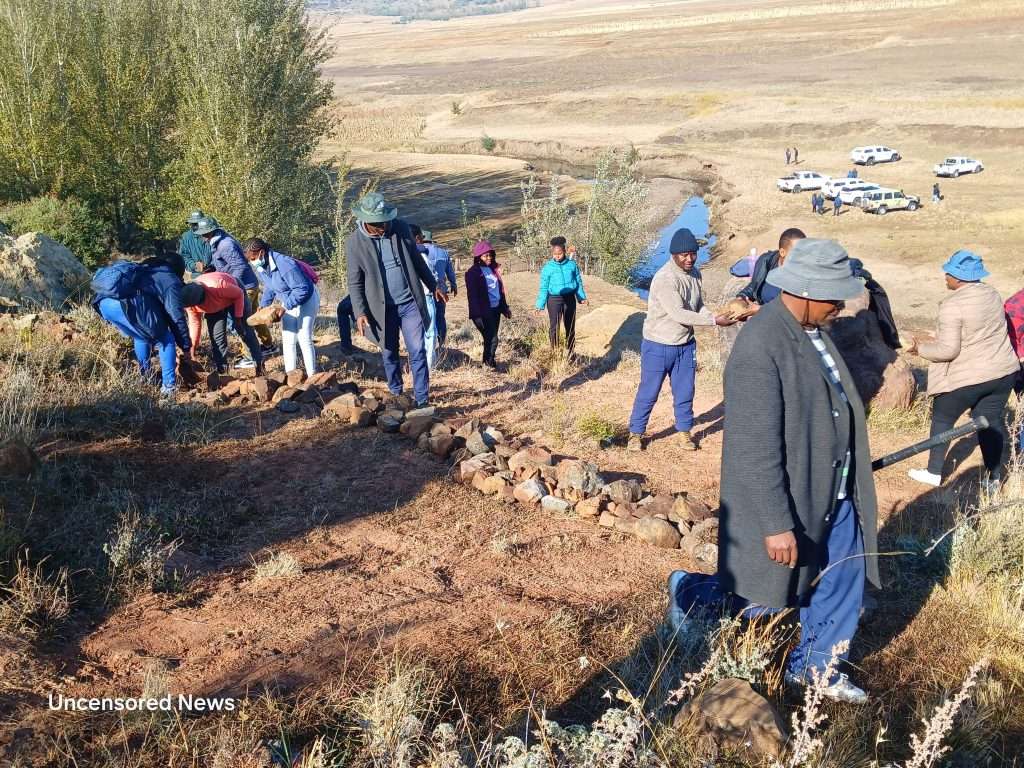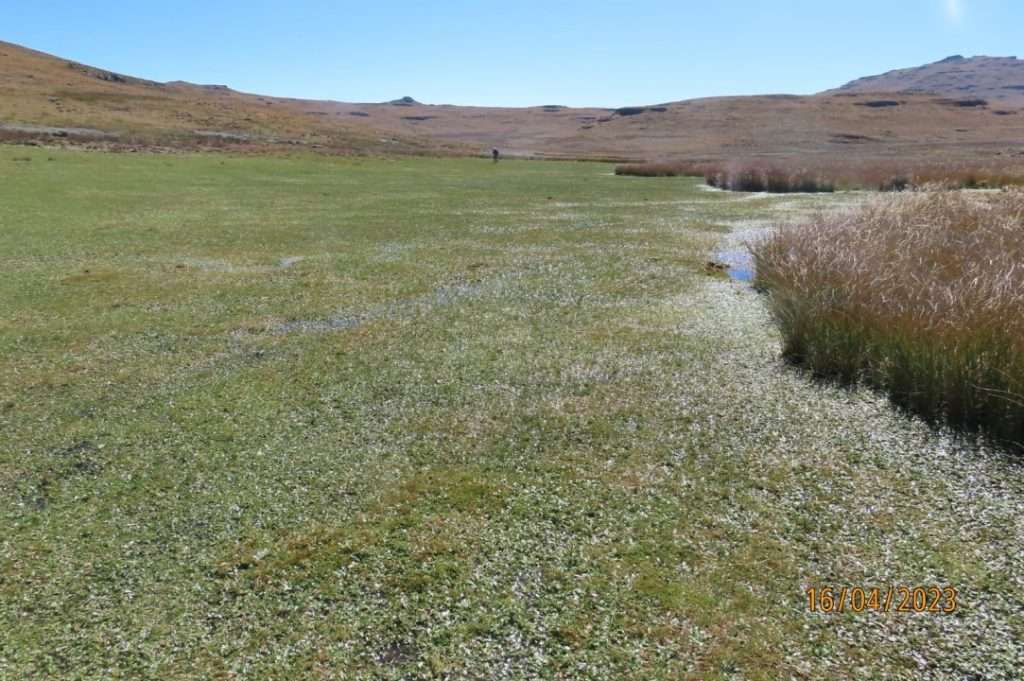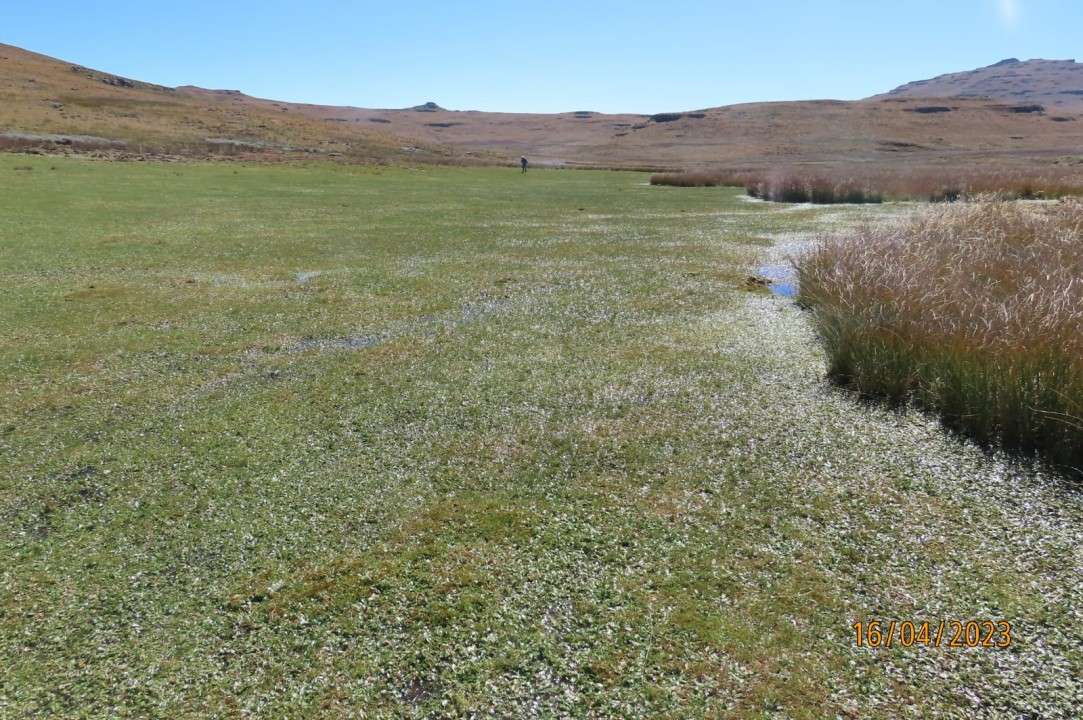How Rangelands Rehabilitation is Offering a Ray of Hope in the Fight Against Climate Change
…In Lesotho, government and LHDA efforts to rehabilitate degraded rangelands are not only revitalising local ecosystems but also providing a sustainable lifeline for communities dependent on agriculture.
28 June 2024 by Pascalinah Kabi
Est. Read Time: 5m 9s
Listen to this article:

Ministry of Environment and Forestry officials demonstrate proper rehabilitation of an Integrated Catchment Management (ICM) of Ha Khoeli during World Desertification Day on June 17, 2024, in Koro-Koro. Photo Credit: Pascalinah Kabi
At 64, Motanya Liphoto has seen it all—from working in the South African mines to helplessly watching the rangelands in his Ha Khoeli village fade away.
As rain patterns drastically change globally, Liphoto observed the degradation of rangelands in Ha Khoeli, a village situated in the Koro-Koro constituency, leaving farmers with little to sustain their livestock.
The degradation also led to the extinction of a type of grass that Basotho use to thatch their traditional huts.
“I was born and raised in that place. We used to harvest the grass used for thatch houses but because of drought, the grass was no longer available,” livestock farmer Liphoto told Uncensored News on June 26, 2024.
Three years ago, the Ministry of Environment and Forestry recognised the plight of the Koro-Koro people and allocated funds for an Integrated Catchment Management programme of a Ha Khoeli rangeland rehabilitation in its 2021/22 fiscal budget.
The ministry engaged ordinary citizens, with the help of experts like ‘Mabatho Nthejane, to rehabilitate the rangeland. The rehabilitation efforts continued in the 2022/23 budget, providing the rangeland the lifeline it needed for full recovery.
“Rangeland rehabilitation efforts need expanded time,” Nthejane said, adding that since 2021, they have not allowed livestock to graze in the Ha Khoeli rangeland to enable full recovery.
Liphoto mentioned that preserving this rangeland has come with challenges as some livestock owners disregard the preservation efforts.
“We have imposed restrictions on livestock whose owners take them there during the night. There are too many challenges in this world; sometimes you think you are making a beautiful development, but others destroy those developments meant for the whole community,” Liphoto said.
In their 2022 study, authors Moselantja Molaoa & Brian Muroyiwa argue that farmers’ participation in Integrated Catchment Management (ICM) initiatives is the cornerstone for soil and water conservation programs.
“Farmers should be motivated so that they could share information, which will enhance their ability to uptake important conservation practices,” Molaoa and Muroyiwa explained.
Community participation
Two years ago, the International Journal of Science and Business published research on factors influencing participation in Integrated Catchment Management (ICM) programs in Lesotho.
The research, conducted by Molaoa and Muroyiwa, noted that Lesotho has suffered severe degradation in both cultivated and rangeland areas. They highlighted that severe degradation is evident through significant soil loss in the form of gully formation, emphasizing the growing importance of ICM in Lesotho.
Molaoa and Muroyiwa explained that Lesotho is a country where most of the population depends on an agricultural economy. This economy is threatened by various forms of land degradation that affect land use patterns.
“ICM requires ongoing participation to engage different stakeholders to address social aspects required to improve environmental approaches, social systems, and policy initiatives,” they explained.
The authors indicated that involving farmers in ICM enhances the community’s environmental problem-solving abilities, which in turn improves the community’s level of empowerment.
“Participation is important for the successful acceptance of programs that facilitate the development of strategies to address soil erosion, drought, and the enhancement of rural livelihoods, reducing incidences of rural unemployment and poverty,” they stated.
Ha Khoeli farmer Motanya Liphoto said that rehabilitating rangelands like the one in his village is not just about environmental protection but also helps farmers and others sustain their lives.
“Once the thatch grass has been harvested, our livestock will be able to graze for an agreed time before we preserve it again,” Liphoto said.
He proposed that the Ministry of Environment and Forestry should extend the ICM program in his village for sustained community development.
Wool and Mohair
In her 2020 thesis for the Doctor of Philosophy in Textile Science at Nelson Mandela University, Papali Maqalika indicated that Lesotho produces significant quantities of Merino apparel wool and mohair.
Maqalika noted that the quality of both wool and mohair allows them to compete on the global market and significantly contribute to Lesotho’s economy.
However, she also observed that the quality and production of Lesotho wool and mohair are greatly influenced by farming practices and climatic conditions.
“The districts in the Highlands region had the highest production of mostly wool, this being ascribed to better pastures, climatic, and other conditions conducive to wool and mohair production,” Maqalika explained.
In 2022, Setibing wool and mohair farmer and chairperson of Tšana-Talana Rangelands, Ramoroa Sekeleme, told Bird Story Agency that the shrub invasion started spreading around 2011.
“That is when we realised that we have a serious challenge. In 2015 we were attacked by a severe drought which worsened the situation,” Sekeleme explained.
In 2015, Lesotho and other southern African nations experienced a severe drought induced by climate change.
Sekeleme said the 2015 drought negatively affected wool and mohair production, with production going down.
“The weight of my wool was very low measured at the shearing shed.”
Worried by this development, Sekeleme said Setibing farmers banded together and formed an association whose responsibilities included rehabilitation of rangelands in their area.
“We established an association called Tšoaranang-ka-Matsoho Makhaleng Grazing Association acting on the advice of the Lesotho Highlands Development Authority.”
Sekeleme said that the association has helped smallholders like him preserve the rangelands since its establishment in 2019.

Meanwhile, just a year ago, the Lesotho Highlands Development Authority (LHDA) expressed concern that wetlands critical to the Lesotho Highlands Water Project (LHWP) are embedded within rangelands extensively used for livestock farming.
“Overgrazing and other poor land use practices lead to a reduction of vegetation cover and degradation of the rangelands and wetlands, which threaten water supply and negatively affect the LHWP,” the LHDA said in a LinkedIn post made in commemoration of World Environment Day.
The LHDA highlighted that it was conducting a baseline wetlands survey and developing a conservation action and monitoring plan for Phase II of the project.
“Last year on the 1st of July, we launched a survey that entails a detailed assessment of the baseline condition of the Phase II wetlands, identification of the priority wetlands for LHWP water delivery, and the development of a conservation and monitoring plan.
“The preliminary survey has identified 950 wetlands in the 13 sub-catchments associated with the five main rivers: Khubelu, Mokhotlong, Moremoholo, Sehonghong, and Senqu, and their tributaries Bafali, Bafatsana, and Lekhalabatesi, which are the main sources of water for the Polihali Dam. The Sehonghong sub-catchment has the largest total area of wetlands and forms part of the priority sub-catchments for its importance in water provision for the Polihali Dam,” read an LHDA post on LinkedIn.
The authority further noted that the wetlands assessment survey is one of the many initiatives undertaken by the LHDA under the Integrated Catchment Management programs.
It indicated that these efforts aim to improve the condition of the highly degraded rangelands, reduce soil erosion, and decrease sedimentation in water sources. It added that this will ensure sustained quality and quantity of water in the LHWP catchment areas and protect endangered species.
“On this World Environment Day, we appeal to Basotho to take steps in changing their land use practices for the improvement of the health and condition of wetlands,” read the post.


